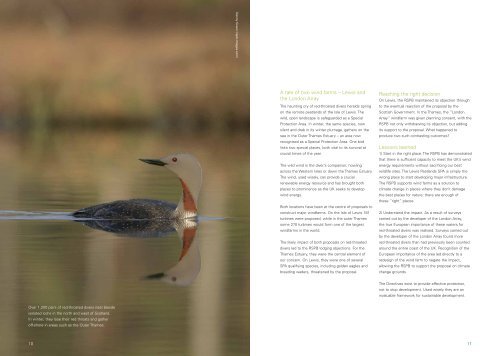The European Birds Directive - RSPB
The European Birds Directive - RSPB
The European Birds Directive - RSPB
You also want an ePaper? Increase the reach of your titles
YUMPU automatically turns print PDFs into web optimized ePapers that Google loves.
Mark Hamblin (rspb-images.com)<br />
Saving special places<br />
<strong>The</strong> <strong>Birds</strong> <strong>Directive</strong> addresses the conservation of all<br />
wild birds across the EU. It includes land and marine<br />
areas, and covers their protection, management,<br />
control and exploitation. It applies to the birds<br />
themselves, their eggs, nests and habitats. Member<br />
States have a requirement to take whatever measures<br />
are necessary to maintain the populations of all wild<br />
birds at levels determined by ecological, scientific and<br />
cultural needs, having regard to economic and<br />
recreational needs.<br />
<strong>The</strong> <strong>Birds</strong> <strong>Directive</strong> makes it a requirement for<br />
Member States of the EU to “preserve, maintain and<br />
re-establish sufficient diversity and area of habitats for<br />
all wild birds”. Achieving this relies on protecting,<br />
managing and restoring the best areas,<br />
complemented by restoring and creating habitats in<br />
the countryside outside such sites. <strong>The</strong> following<br />
section looks at key aspects of that requirement –<br />
the identification, designation, protection and<br />
management of Special Protection Areas (SPAs).<br />
<strong>The</strong>se are just some of the special actions a Member<br />
State must take for rare, threatened or vulnerable<br />
species on Annex 1 of the <strong>Directive</strong>, as well as for<br />
regularly occurring migrants. <strong>The</strong>re is an emphasis on<br />
wetlands, especially those that are internationally<br />
important. <strong>The</strong> network of sites should include the<br />
breeding, moulting and wintering areas for the<br />
species concerned, as well as vital staging posts<br />
along their migration routes.<br />
<strong>The</strong> identification, designation, protection and<br />
management of SPAs all create challenges, which<br />
need to be met if the purpose of the <strong>Directive</strong> is to<br />
be fully met.<br />
Each year, Loch Garten SPA and <strong>RSPB</strong> nature reserve<br />
is visited by approximately 33,000 people. People<br />
attracted to coming to see the ospreys there bring<br />
£1.5 million to the local economy.<br />
DEFINITION OF NATURA 2000 –<br />
A NETWORK FOR LIFE<br />
Imagine a network of the very best places for<br />
nature spread across all 27 countries of the<br />
<strong>European</strong> Union – from sweeping coastal<br />
wetlands, through towering forests to the highest<br />
mountains. <strong>The</strong>se are some of the most iconic<br />
and most loved landscapes of Europe. <strong>The</strong>ir<br />
protection should be a natural reaction to their<br />
beauty and intrinsic value.<br />
<strong>The</strong> good news is that such a network – though in<br />
parts incomplete – exists. It is called Natura 2000.<br />
It is made up of Special Areas of Conservation<br />
designated under the 1992 Habitats <strong>Directive</strong> and<br />
Special Protection Areas designated under the<br />
1979 <strong>Birds</strong> <strong>Directive</strong>. <strong>The</strong>se are selected against<br />
rigorous scientific criteria to protect the most<br />
threatened and important species and habitats in<br />
Europe. <strong>The</strong>y are not, generally, nature reserves;<br />
their emphasis is on ensuring that future<br />
management is sustainable, both ecologically and<br />
economically. <strong>The</strong> network of protected areas also<br />
fulfils some of the <strong>European</strong> Commission’s<br />
obligations under the UN’s Convention on<br />
Biological Diversity.<br />
<strong>The</strong> <strong>RSPB</strong>’s network of nature reserves<br />
encompasses over 90 SPA sites in the UK. We<br />
also work through the planning system to try and<br />
ensure development proposals do not harm SPAs.<br />
In 2007 we engaged in 253 proposals affecting<br />
SPAs. We campaign to ensure that the UK<br />
Government honours its commitment to<br />
designate sufficient Natura 2000 sites, to meet<br />
its obligations to conserve Europe’s most<br />
important species and habitats.<br />
6 7
















